Welcome To The Automotive Leather ID Guide
Understanding leather is the foundation of proper care and restoration, whether you're a seasoned professional or just beginning your journey. Leather comes in various types, each with unique qualities and needs. This guide will help you distinguish between leather types and understand their characteristics, so you can make informed decisions for care and maintenance.
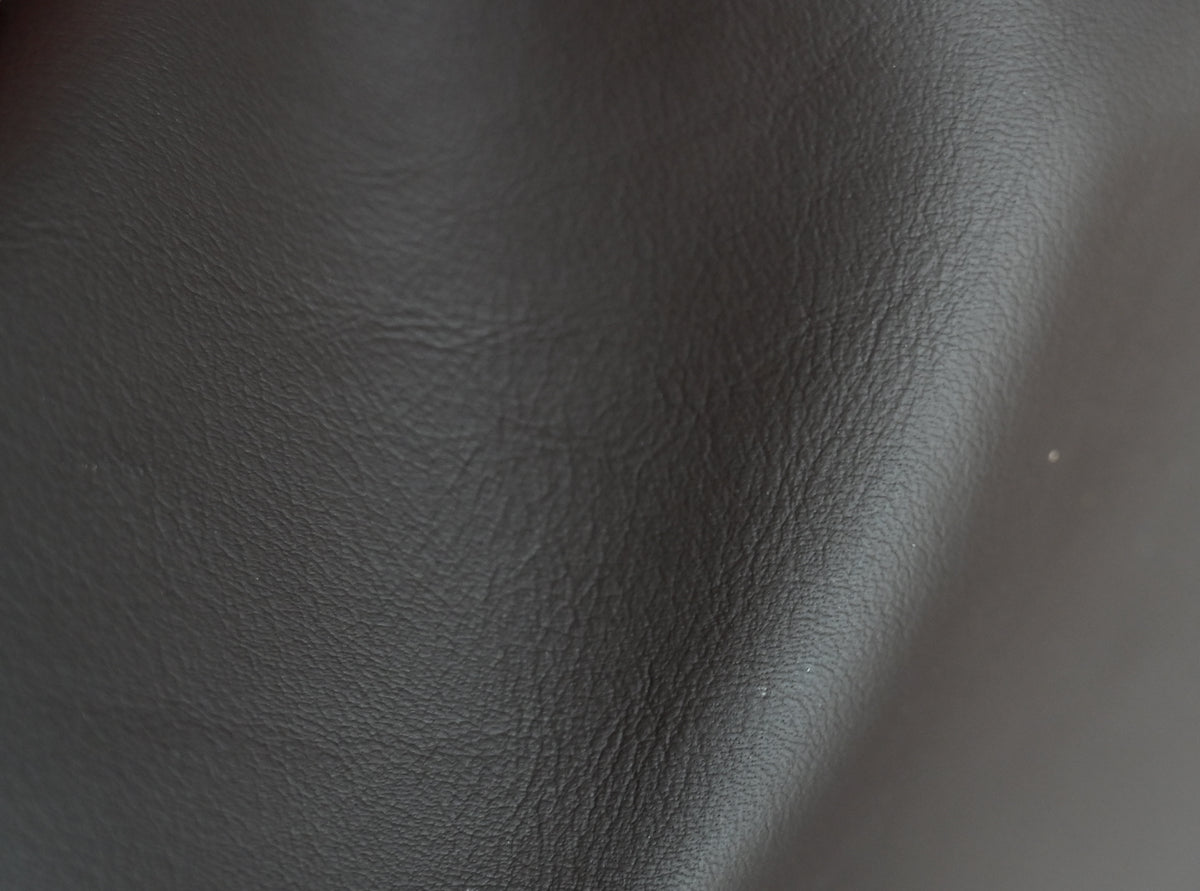
"Leather tells a story of craftsmanship, history, and luxury. Understanding what type of leather or material you're working with is the first step in maintaining its beauty and integrity. Whether it's aniline, pigmented leather, or even vinyl, our guide will help you identify and care for it with confidence."
Identify
Key Leather Types:
Aniline Leather
- Appearance: Natural, vibrant color with visible grain and imperfections. Often soft to the touch with a matte or light sheen.
- Key Traits: Highly absorbent, prone to stains and fading. Requires gentle cleaning and conditioning.
- How to Identify: Press lightly with a damp cloth—if it darkens immediately, it's likely aniline. Additionally, examine the surface for visible natural imperfections like scars or wrinkles. Aniline leather will have a soft and warm feel, unlike coated or synthetic materials.
Semi-Aniline Leather
- Appearance: Similar to aniline but with a light protective coating. Offers more consistency in color and sheen.
- Key Traits: Less absorbent than aniline but still showcases natural grain. Easier to maintain.
- How to Identify: Slightly darkens with water but not as quickly as aniline. Inspect for a subtle topcoat by running your fingers over the surface; it should feel slightly smoother and less porous compared to full aniline leather.
Pigmented Leather
- Appearance: Uniform color and a more artificial look due to the pigment layer. Often glossy.
- Key Traits: Very durable, water-resistant, and scratch-resistant.
- How to Identify: Scratch lightly with a fingernail—pigmented leather often resists visible damage. Check for uniformity in texture and color, as natural imperfections are often hidden under the pigment.
Nubuck Leather
- Appearance: Soft, velvety texture achieved by sanding the top grain.
- Key Traits: Very delicate and absorbent, prone to stains and scratches.
- How to Identify: Rub gently with your finger—the color will temporarily darken. Examine the texture closely for a fine, suede-like nap that responds to touch, creating a subtle color shift.
Suede Leather
- Appearance: Fuzzy texture, similar to nubuck but from the underside of the hide.
- Key Traits: Delicate and easily soiled. Requires special care products.
- How to Identify: Texture is softer and less uniform compared to nubuck. Look for a looser, more open nap and a matte finish, as suede is generally less structured than nubuck.
Vinyl and Faux Leather
- Appearance: Synthetic material designed to mimic leather. Often overly consistent in texture and sheen.
- Key Traits: Non-porous, resistant to most stains, and less breathable than genuine leather.
- How to Identify: Scratch with a fingernail—it often leaves no visible mark. Also, it won’t absorb water. Look for a uniform, plastic-like finish and a colder, less organic feel compared to genuine leather.
Automotive Leather Evolution
The evolution of automotive leather reflects the intersection of innovation, comfort, and style in vehicle interiors. Here’s a look at how it has developed over time:
Early Automotive Interiors: Function Over Comfort
In the earliest vehicles, interiors were dominated by materials like wood and metal, which were sturdy but uncomfortable. Leather was introduced as a way to soften and elevate the experience, offering a more luxurious alternative. However, early leather, often vegetable-tanned, became stiff and brittle when exposed to varying environmental conditions, such as heat and humidity.
The Shift to Chrome-Tanning
By the mid-20th century, chrome-tanned leather began to replace vegetable-tanned options in automotive interiors. Chrome tanning offered greater flexibility, softness, and resistance to environmental stressors. This innovation made leather more durable and suitable for the demands of daily driving.
Post-War Era: The Rise of Luxury
The 1950s and 1960s marked a golden age for automotive interiors. Cars like Rolls Royce, Mercedes-Benz, and Cadillac featured supple leather upholstery as a hallmark of luxury. Unique features such as tufted seating, contrasting piping, and hand-stitched detailing became popular, showcasing craftsmanship and exclusivity.
The Dawn of Vinyl
In the mid-20th century, vinyl emerged as a practical and affordable alternative to leather. Companies like Chevrolet, particularly with their Corvette models, introduced vinyl as a durable, easy-to-clean material that offered a similar aesthetic to leather at a lower cost. Vinyl became especially popular in mass-market vehicles during the 1950s and 1960s due to its resistance to stains and cracking, making it a preferred choice for family cars. However, vinyl lacked the breathability and luxurious feel of genuine leather, solidifying leather’s place in higher-end vehicles.
Modern Automotive Leather: Innovation Meets Practicality
Today’s automotive leather blends advanced tanning techniques with synthetic enhancements for durability and ease of care. Semi-aniline and pigmented leathers dominate the market, offering a balance between luxury and practicality. Innovations such as perforated leather for ventilation and stain-resistant coatings cater to modern consumer needs.
How Leather Tanning Impacts Cleaning and Care
- Early Leather (Vegetable-Tanned): Required frequent conditioning to maintain softness and was prone to cracking if neglected.
- Chrome-Tanned Leather: More forgiving, requiring less frequent conditioning and better resisting environmental damage.
- Modern Coated Leathers: Easier to clean and maintain due to protective finishes, but they require specialized products to avoid damaging the topcoat.
Trends and Unique Features in Automotive Leather
- Vintage Interiors: Characterized by rich patinas, natural imperfections, and hand-stitched craftsmanship. These leathers often require restoration to address fading, cracking, or stiffness.
- Modern Interiors: Focused on comfort and technology, with features like heated and ventilated seats, which influence leather choice and care practices.
- Sustainability: Eco-friendly tanning methods, such as chrome-free and vegetable tanning, are gaining traction as consumers prioritize sustainability.
Understanding Pigments in Automotive Leather
Pigments are a critical component in the production of pigmented leather, providing color and a protective barrier that enhances durability. Understanding pigments and their role can help in proper maintenance and care:
- What Are Pigments?: Pigments are finely ground particles suspended in a medium that adhere to the leather’s surface. They are responsible for the even, uniform color seen in pigmented leathers.
- How Pigments Are Applied: During manufacturing, pigments are sprayed or rolled onto the leather surface in thin, even layers. A topcoat is then applied to seal and protect the pigment layer, providing resistance to stains and wear.
- Impact on Leather Characteristics: The application of pigments and topcoats can reduce the leather’s natural breathability and ability to absorb moisture. While this increases durability and stain resistance, it may result in a cooler, less organic feel compared to natural or semi-aniline leathers.
- Maintenance Tips for Pigmented Leather:
- Use pH-balanced cleaners to avoid breaking down the pigment or topcoat layers.
- Condition the leather to prevent the topcoat from becoming brittle over time.
- Avoid harsh chemicals or abrasive tools that can scratch or strip the pigment layer.
- Environmental Considerations: Geographic factors such as humidity, temperature extremes, and UV exposure can affect the longevity of pigments. Regular application of UV protectants and maintaining a stable interior environment are essential to preserving pigmented leather.
Common Vehicle Interior Problems
-
UV Damage
- Issue: Prolonged sun exposure causes fading, discoloration, and drying.
- Solution: Apply a UV-protectant leather conditioner regularly to block harmful rays. Use window shades or UV-blocking films on windows. When parking for extended periods, cover seats with breathable covers to shield them from sunlight.
- Recommended Tools: Soft microfiber cloths, application sponges, and UV protection sprays or creams.
-
Cracking
- Issue: Leather loses moisture, becoming brittle and prone to cracks.
- Solution: Condition the leather every 1-3 months, depending on use, to replenish lost oils. Avoid over-conditioning, as it can lead to residue build-up. Maintain a stable temperature in the vehicle to prevent excessive drying.
- Recommended Tools: High-quality applicator pads and soft brushes for deep conditioning.
-
Dye Transfer
- Issue: Clothing, such as jeans, can transfer dyes onto light-colored leather.
- Solution: Clean dye stains promptly using a leather-safe cleaner. For stubborn stains, lightly buff with a soft leather-safe eraser. Apply a protective coating to prevent future dye transfer.
- Recommended Tools: Leather erasers, pH-neutral cleaners, and lint-free cleaning cloths.
-
Staining
- Issue: Spills and food can leave permanent marks if not addressed quickly.
- Solution: Blot spills immediately using an absorbent, non-abrasive cloth. Avoid rubbing, which can spread the stain. Follow up with a mild cleaner to remove any residue.
- Recommended Tools: Absorbent towels, gentle cleaning brushes, and stain-removal kits.
-
Creases and Wrinkles
- Issue: Regular use causes creasing in high-contact areas like seats.
- Solution: Use heat and moisture carefully to relax creases. Steamers or heated tools, combined with a conditioner, can help smooth out light creases. For deep wrinkles, professional restoration may be needed.
- Recommended Tools: Leather-safe steamers and precision heat tools.
-
Scratches and Scuffs
- Issue: Sharp objects or heavy use can cause surface damage.
- Solution: Repair light scratches with a leather repair balm or filler. For deeper scuffs, apply a thin layer of leather filler, smooth it out, and color-match with a leather dye.
- Recommended Tools: Leather filler tools, color-matching dye kits, and applicator brushes.
-
Dryness
- Issue: Environmental conditions or neglect can dry out leather.
- Solution: Regularly condition leather with a product designed to hydrate and protect. Avoid storing the vehicle in overly dry or excessively hot conditions.
- Recommended Tools: Conditioning pads and soft application cloths.
-
Sticky or Oily Residues
- Issue: Body oils and improperly cleaned spills can leave sticky surfaces.
- Solution: Use a leather-safe degreaser to clean the affected area. Follow up with a conditioner to restore the leather’s natural texture.
- Recommended Tools: Degreasing agents, microfiber towels, and applicator pads.
-
Fading
- Issue: Over time, leather loses its original vibrancy.
- Solution: Restore faded leather with recoloring balms or dyes. Always clean and prep the surface before applying any color to ensure even coverage.
- Recommended Tools: Leather dye applicators, sponges, and color-protection sprays.
-
Peeling or Delamination
- Issue: Coated leathers may peel or flake with age or misuse.
- Solution: Remove loose fragments carefully, then use a leather repair filler to smooth the area. Apply a new protective coating to prevent further delamination.
- Recommended Tools: Sanding sponges, filler tools, and clear coat applicators.
-
Odor Retention
- Issue: Leather can absorb unpleasant smells like smoke or spills.
- Solution: Clean the surface thoroughly and use a leather-safe deodorizer. Place odor-absorbing materials, such as activated charcoal pouches, in the car for ongoing freshness.
- Recommended Tools: Deodorizing sprays and odor-neutralizing pads.
-
Swelling
- Issue: Excess moisture can cause leather to swell and deform.
- Solution: Dry the affected area using fans or dehumidifiers. Avoid direct heat, which can cause further damage. Once dry, condition the leather to restore flexibility.
- Recommended Tools: Dehumidifiers, airflow fans, and moisture-absorbing cloths.
-
Mold and Mildew
- Issue: High humidity or water exposure can lead to the growth of mold or mildew, which damages the leather and creates unpleasant odors.
- Solution: Use a leather-safe anti-fungal cleaner to remove mold. Ensure the vehicle is properly ventilated, and use moisture absorbers to prevent recurrence.
- Recommended Tools: Anti-fungal cleaning sprays, ventilation fans, and absorbent towels.
-
Burns and Heat Damage
- Issue: Cigarette burns or excessive heat from hot items left on seats can leave permanent marks or damage the leather surface.
- Solution: For minor burns, smooth out the area with a leather repair filler and apply matching dye. Severe burns may require panel replacement.
- Recommended Tools: Burn repair kits, filler tools, and dye applicators.
-
Loss of Gloss or Finish
- Issue: Over time, the protective finish or natural gloss on leather may dull due to wear or improper cleaning methods.
- Solution: Reapply a leather finish or gloss enhancer that matches the original sheen. Ensure the surface is clean and dry before application.
- Recommended Tools: Applicator pads, finishing sprays, and polishing cloths.
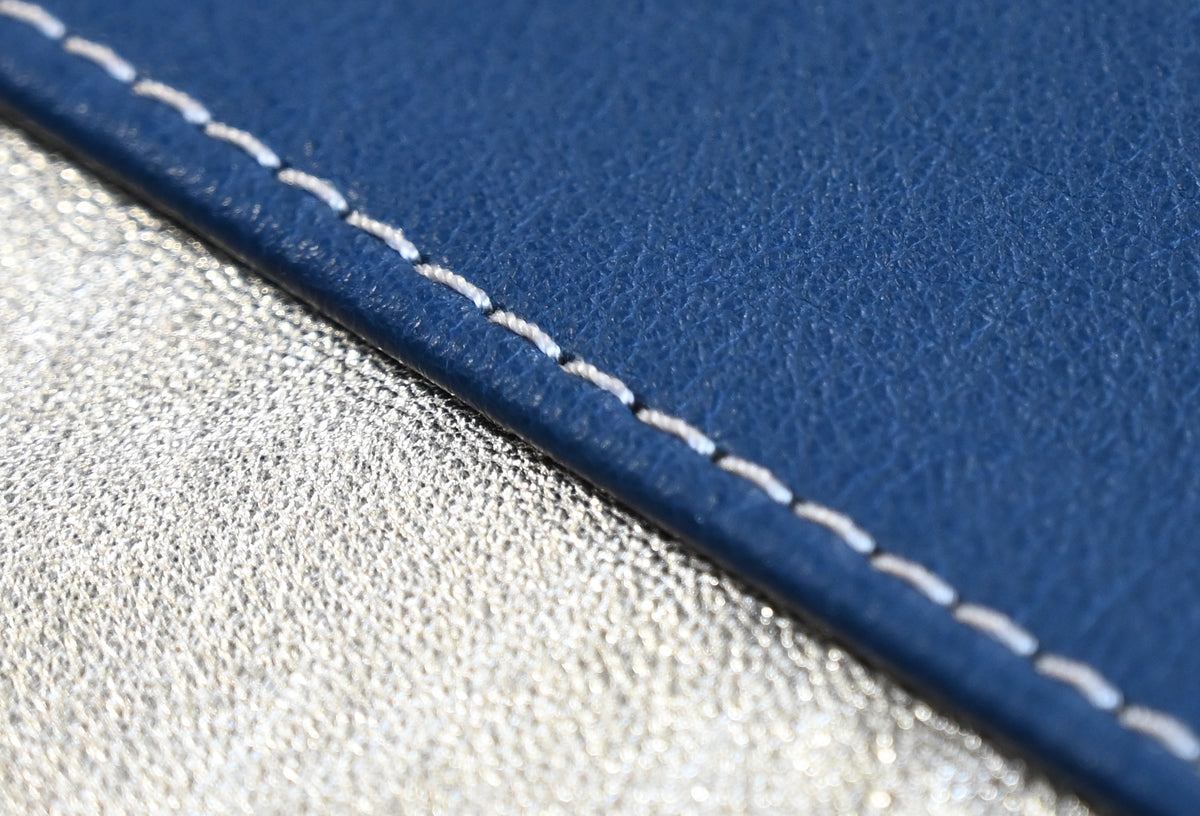
Vinyl / PVC
Vinyl, often referred to as synthetic leather, faux leather, or PVC (polyvinyl chloride), is a man-made material designed to mimic the appearance of leather. It is made by coating a fabric base, such as polyester, with a plasticized PVC layer, creating a durable and flexible surface. Vinyl is widely used in cars due to its affordability, resistance to stains, water, and UV exposure, and ease of cleaning. Its versatility and customizable finishes make it an ideal choice for automotive interiors, providing a leather-like aesthetic without the higher cost or maintenance requirements of genuine leather.
Vinyl vs. Leather in Cars
A practical guide for detailers to distinguish between the two and choose appropriate care methods:
Identifying Leather vs. Vinyl:
- Texture and Feel: Leather tends to feel warmer and more organic, with natural imperfections, while vinyl is smoother and often colder to the touch.
- Pores and Grain: Leather exhibits irregular grain patterns and pores, whereas vinyl has uniform, embossed patterns.
- Water Absorption: Leather will absorb small amounts of water, darkening temporarily, while water beads on vinyl surfaces without absorption.
- Stretch Test: Gently stretching leather reveals subtle changes in texture; vinyl remains consistent due to its synthetic composition.
Care Practices for Leather:
- Use leather-specific cleaners and conditioners.
- Avoid oversaturating with water to prevent swelling or damage.
- Protect with UV inhibitors to prevent fading.
Care Practices for Vinyl:
- Clean with mild, all-purpose cleaners designed for synthetic materials.
- Avoid harsh chemicals that can dry out or crack the vinyl.
- Use protectants to maintain flexibility and prevent UV damage.
Blended Materials in Automotive Interiors
How and Why Automakers Blend Leather with Vinyl
Automakers often blend leather with vinyl in vehicle interiors for several practical and economic reasons:
- Cost Efficiency: Genuine leather is more expensive to source and process. By using leather only in high-contact or visible areas, such as seat cushions and backrests, and vinyl in less noticeable sections, like seat sides and backs, manufacturers reduce production costs while maintaining a premium appearance.
- Durability in High-Stress Areas: Vinyl is tougher and more resistant to wear in certain areas, such as seat bolsters or door panels. These are regions prone to scuffing, stretching, and abrasion, where vinyl’s resilience outperforms leather.
- Ease of Maintenance: Vinyl is less porous than leather, making it more resistant to stains, liquids, and oils. Blending it with leather simplifies cleaning and maintenance for owners.
- Weight Reduction: Vinyl is lighter than leather. In performance-focused or fuel-efficient vehicles, reducing weight without sacrificing luxury is a key consideration.
- Aesthetic Consistency: Modern vinyls can be manufactured to closely mimic leather's texture, grain, and color, creating a seamless appearance when used alongside real leather.
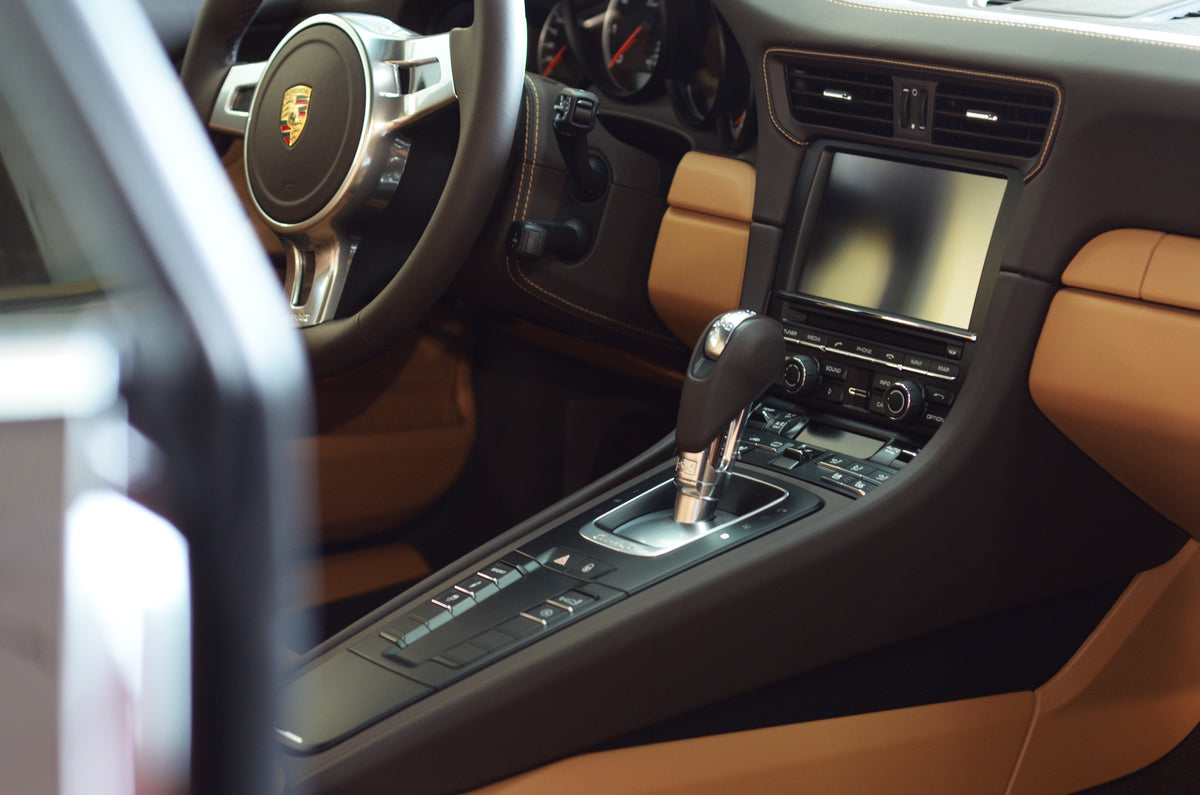
High Traffic Areas
High-Traffic Areas of Leather in Vehicles: Impact and Care
In vehicles, certain leather areas experience consistent contact and are considered "high-traffic" zones. These include seat bolsters, armrests, headrests, steering wheels, and door panels. Over time, these areas are particularly vulnerable to changes caused by exposure to body oils, sweat, makeup, and environmental factors.
Causes of Wear and Alteration
- Body Oils and Sweat
Prolonged exposure to natural oils from skin and sweat can seep into the leather, causing darkening, a greasy sheen, or weakening of the protective topcoat. This is especially prominent on headrests, armrests, and seat bolsters.
- Makeup and Skincare Products
Cosmetics, lotions, and sunscreens can transfer onto the leather, leaving residues that attract dirt and create uneven discoloration. These products often contain chemicals that may break down the leather's finish over time.
- Environmental Factors
Dust, dirt, and debris combined with friction can create micro-abrasions on leather surfaces, leading to a dull or uneven appearance in high-use areas.
How Leather Alters Over Time
- Loss of Protective Coating:
High-traffic areas with frequent use can experience a gradual breakdown of the leather’s protective layer, making it more susceptible to staining and absorbing external substances. - Color Change:
Light-colored leathers often show visible darkening, while darker leathers may develop patchy or uneven tones due to embedded oils or residues. - Textural Changes:
Leather in high-traffic zones can become smoother, glossier, or even sticky as it absorbs substances and loses its natural finish.
Prevention and Maintenance
- Regular Cleaning:
Clean high-traffic areas frequently using pH-balanced leather cleaners to remove oils, sweat, and product residues before they penetrate the leather surface. - Protective Treatments:
Apply leather protectants or sealants to create a barrier that reduces absorption and makes cleaning easier. - Targeted Conditioning:
Use conditioners sparingly on high-traffic zones to maintain leather’s suppleness without overloading it with oils. - Avoid Direct Contact with Contaminants:
Encourage habits such as wiping off sweat, oils, or makeup before entering the vehicle or using seat covers for added protection.
By recognizing and addressing the unique challenges of high-traffic leather areas, vehicle owners can maintain their leather’s natural appearance and extend its lifespan, preserving the luxury and value of their interiors.

Identifying Leather in Different Brands: Luxury vs. Standard Vehicles
Luxury brands like Ferrari, Rolls Royce, and Mercedes often use premium leather, such as full-grain or semi-aniline, to enhance the feel and aesthetics of their interiors. These leathers are softer, more supple, and showcase natural grain patterns, but they require more delicate care due to reduced protective coatings.
In contrast, standard brands typically use pigmented or coated leather, valued for its durability and stain resistance. While less natural in appearance, these leathers are easier to maintain and better suited for daily use.
Recognizing these differences allows for tailored care that preserves the unique beauty and durability of each vehicle’s leather, keeping it looking exceptional!
Leather Stains in Vehicle Interiors
Leather Stains in Vehicle Interiors: A Guide to Identification and Care
Stains are among the most common and frustrating issues affecting leather interiors in vehicles. Whether it’s a splash of coffee, a pen mark, or dye transfer from clothing, these blemishes can detract from the elegance and value of your vehicle. Understanding the types of stains and how to address them is key to maintaining your leather's beauty and longevity.
Common Types of Leather Stains in Vehicles:
- Dye Transfer: Often caused by jeans, dark clothing, or belts, dye transfer is a prevalent issue on light-colored leather.
- Oil and Grease: From skin contact, food, or accidental spills, oils can darken leather over time.
- Ink Stains: Marks from pens or markers are particularly stubborn and may require specialized cleaners.
- Liquid Spills: Drinks like coffee, soda, or wine can leave discoloration if not cleaned immediately.
- Water Stains: Hard water droplets can leave mineral deposits on leather surfaces.
- Environmental Residue: Dust, grime, and road debris can embed into leather pores, causing unsightly discoloration over time.
How Leather Reacts to Stains
The porous nature of leather means it can absorb stains quickly, especially if it’s untreated or lightly finished (such as aniline leather). Pigmented or coated leathers, more common in automotive interiors, offer some resistance but are not immune to permanent damage if stains are left untreated.
Stain Removal and Care Tips:
- Act Quickly: The sooner a stain is addressed, the better the chances of removal.
- Identify the Leather Type: Understanding whether your leather is aniline, semi-aniline, or pigmented determines the appropriate cleaning method.
- Use the Right Products: Always choose pH-balanced, leather-safe cleaners to avoid damaging the material.
- Blot, Don’t Scrub: Use a soft cloth to blot stains gently. Scrubbing can push the stain deeper into the leather or damage the finish.
- Test Before Applying: Always test cleaners or conditioners on an inconspicuous area first to ensure compatibility.
When to Seek Professional Help
Some stains, such as ink or severe dye transfer, may penetrate deeply into the leather, making DIY removal challenging. In such cases, professional leather care services can provide advanced solutions, including recoloring or refinishing the affected area.
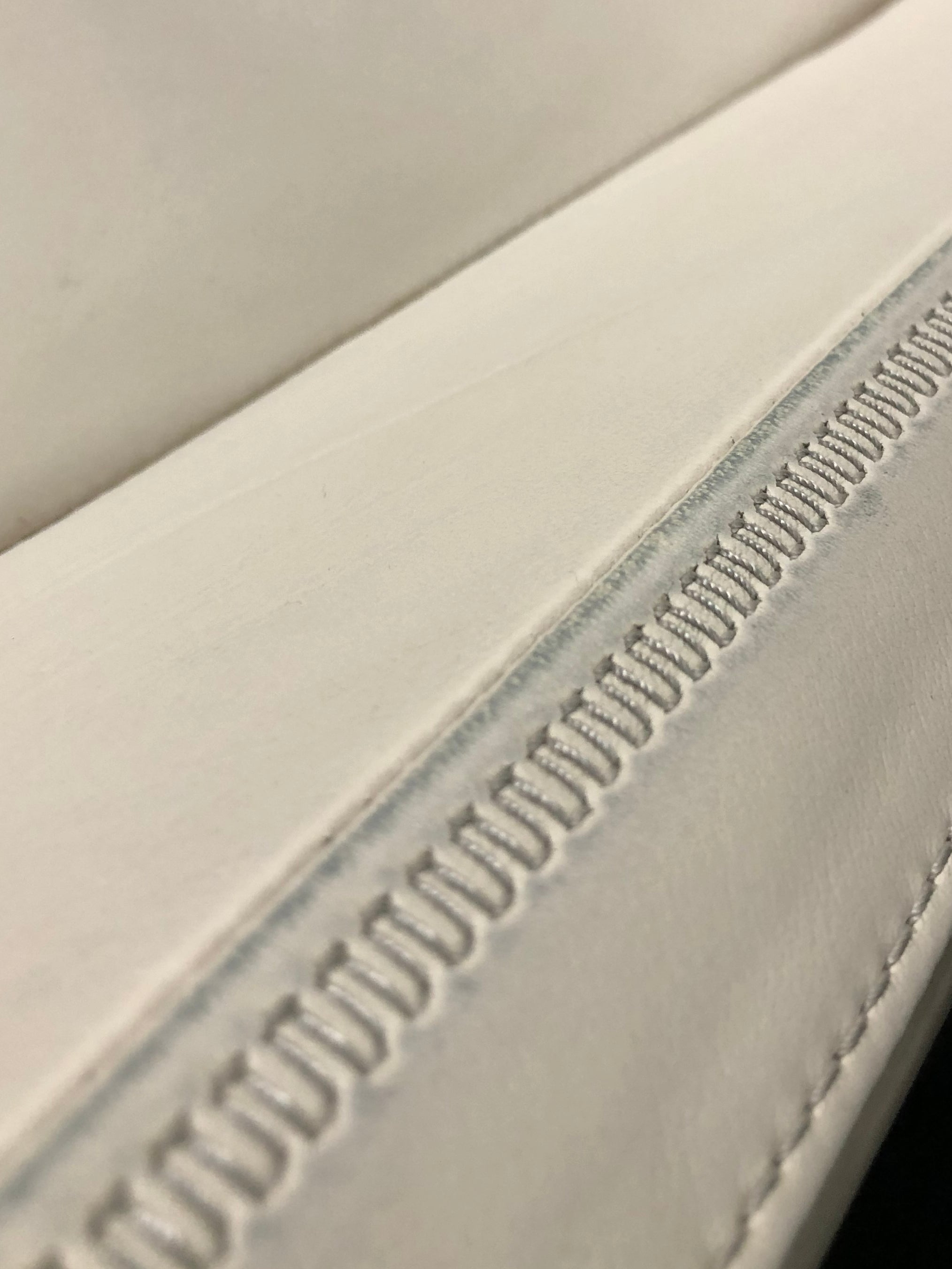
Dye Transfer
Understanding Dye Transfer: Causes, Prevention and Solutions:
Dye transfer occurs when pigments from clothing, accessories, or other materials rub off onto leather surfaces, leaving noticeable stains or discoloration. This is particularly common with dark or heavily dyed fabrics, such as denim, which can transfer pigments onto lighter-colored leathers. Dye transfer happens due to friction and the natural absorbency of leather, which allows the pigments to embed themselves into the leather’s surface.
Why Some Leathers Are More Prone to Dye Transfer:
Semi-Aniline and Sensitive Leathers
Semi-aniline leathers, prized for their softness and natural appearance, have a thinner topcoat and reduced pigmentation compared to fully pigmented leathers. This makes them more susceptible to dye transfer as the surface is less sealed, allowing colors to penetrate more easily.
High-end vehicles often feature such leathers to achieve a luxurious, supple feel. However, this quality comes at the cost of increased sensitivity to stains and wear.
Light-Colored Leathers
Light and white leathers visibly show dye transfer more than darker leathers, but the issue can occur on darker tones as well—it’s just harder to detect. Over time, unseen dye transfer on darker leathers can still lead to discoloration or uneven surface appearance.
Topcoat and Pigment Levels
Leather with minimal protective coatings is more vulnerable. In contrast, heavily pigmented or protected leathers, such as pigmented automotive leather, have stronger barriers that resist dye transfer.
Preventing Dye Transfer:
Regular Cleaning and Conditioning
Frequent cleaning with pH-balanced leather cleaners can remove dye particles before they embed deeply. Follow with conditioners that maintain the leather's integrity and create a mild barrier against absorption.
Protective Coatings
Apply leather protectors or sealants designed for automotive leather. These products create an invisible layer that reduces friction and blocks dyes from penetrating the leather surface. Reapply regularly for continued effectiveness.
Avoid High-Risk Contact
Minimize prolonged contact with heavily dyed clothing or accessories. Placing a protective cover or using care when wearing dark denim or new fabrics can reduce transfer.
Awareness of Friction Points
High-friction areas, such as seat edges, armrests, and steering wheels, are more likely to experience dye transfer. Focus preventive measures on these zones.
Addressing Severe Dye Transfer:
Recoloring for Severe Cases
When dye transfer has deeply penetrated the leather, cleaning alone may not resolve the issue. In these cases, professional recoloring may be required. This process restores the original color while applying a stronger protective topcoat to prevent recurrence.
Blocker Products
Blocker products can help by neutralizing the pigments that cause dye transfer, ensuring they don’t reappear on the leather’s surface after cleaning or use.
Professional Assessment
Severe dye transfer often requires professional evaluation to determine the best restoration approach, particularly for high-end or delicate leathers.
Important Notes About Dye Transfer
Invisible Issues on Dark Leathers
While darker leathers may not visibly show dye transfer, the absorption can still degrade the leather over time, resulting in uneven wear, discoloration, or a dull appearance.
Routine Maintenance Is Key
High-end vehicles with sensitive leather interiors require consistent maintenance to preserve their luxurious feel and appearance. This includes applying protectants, performing gentle cleaning, and monitoring for early signs of wear.
By addressing dye transfer with a comprehensive understanding of leather’s properties, preventive strategies, and professional solutions, it’s possible to maintain the beauty and longevity of leather surfaces, particularly in high-end and luxury applications.
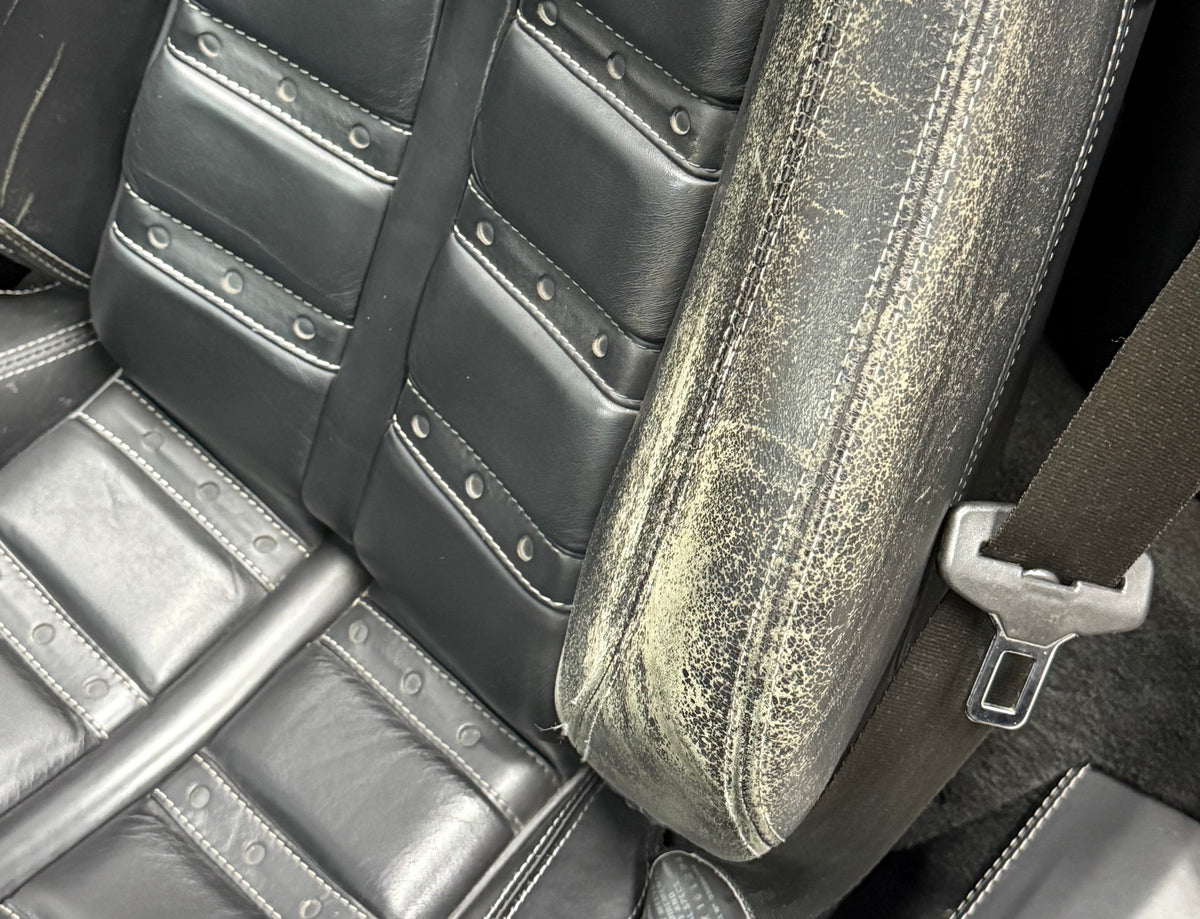
Brittle and Stiff Older Leather
What Causes Brittleness in Older Leather?
Loss of Natural Oils: As leather ages, its natural oils evaporate, leading to stiffness and cracking.
Environmental Exposure: Prolonged exposure to UV light, heat, and fluctuating humidity accelerates leather deterioration.
Neglected Maintenance: Without regular cleaning and conditioning, dirt, grime, and moisture weaken leather fibers over time.
Chemical Damage: Improper cleaning products or harsh chemicals can strip the leather of its protective coatings and moisture balance.
Aging Tanning Process: Vintage leather often used different tanning methods, which can break down differently compared to modern techniques.
Step-by-Step Care for Brittle and Stiff Older Vehicle Leathers
Restoring older leather is not a quick task—it’s a labor of love that mirrors the original tanning process to bring life back to the hide. A well-done reconditioning can take several days to ensure the leather regains its suppleness and durability. This approach respects the craftsmanship of vintage vehicle interiors, luggage sets, and tool bags, treating the leather as the timeless material it is.
Step 1: Assess the Leather’s Condition
Start by carefully evaluating the leather to understand its needs.
- Look for cracks, dryness, or signs of structural weakening.
- Test an inconspicuous area to determine the leather's responsiveness to treatment.
- Recognize that some leather may no longer be treatable due to extreme degradation.
Life Expectancy of Leather: With proper care, high-quality leather can last for decades—even centuries. However, when neglected, its lifespan is drastically reduced.
Step 2: Gently Clean the Surface
Cleaning is the foundation of restoration and must be done with patience and care.
- Remove dust and surface dirt using a soft brush or microfiber cloth.
- Use a pH-balanced leather cleaner designed for automotive or vintage leather.
- Avoid soaking the leather. Excess water can disrupt the leather’s delicate pH balance, leading to brittleness or further damage.
- Gently blot the leather dry with a soft, lint-free cloth.
Understanding pH: Leather’s ideal pH is slightly acidic (around 4.5-5.5). When pH levels are too high, leather becomes prone to brittleness, cracking, and fiber breakdown. Conversely, when the pH is too low, the leather can weaken, lose its flexibility, and become overly delicate.
Step 3: Rehydrate the Leather Gradually
Rehydration is the most critical step and requires a methodical, tannery-inspired approach.
- Use a high-quality leather conditioner tailored for aging leather.
- Massage the conditioner into the leather in small, circular motions, focusing on the driest and stiffest areas.
- Allow the conditioner to absorb slowly, which may take several hours or even overnight.
- Repeat this process in thin, even layers over several days if needed.
Reconditioning Insight: Restoring leather is like recreating the tanning process—step by step, layer by layer. Rushing this process can overwhelm the leather, leaving it oily or structurally compromised.
Step 4: Repeat and Monitor Progress
Older leather often requires multiple rounds of conditioning over time.
- Space out treatments to allow the fibers to fully absorb oils and regain elasticity.
- Be patient; the transformation may take days or even weeks, depending on the leather's condition.
- Avoid over-saturating the leather, which can lead to a tacky surface and weaken its fibers.
Step 5: Protect and Preserve
Once reconditioned, protect the leather to ensure its longevity.
- Apply a leather protectant with UV-blocking properties to shield it from future damage.
- For luggage or tool bags, store items in a cool, dry environment with moderate humidity to prevent reoccurring brittleness.
Step 6: Handle With Respect
Vintage leather requires gentle handling, especially during restoration.
- Avoid pulling or flexing stiff areas excessively, as this could lead to tearing.
- Use supportive measures when storing or displaying vintage items to prevent unnecessary strain.

Caring for Older Leather
Restoring brittle leather is an art that honors its history and craftsmanship. Vintage leather holds stories and character that modern materials often lack. With patience and care, this reconditioning process can bring even the most aged leather back to life. While some cases may require professional attention, your effort preserves its beauty and ensures its legacy endures.
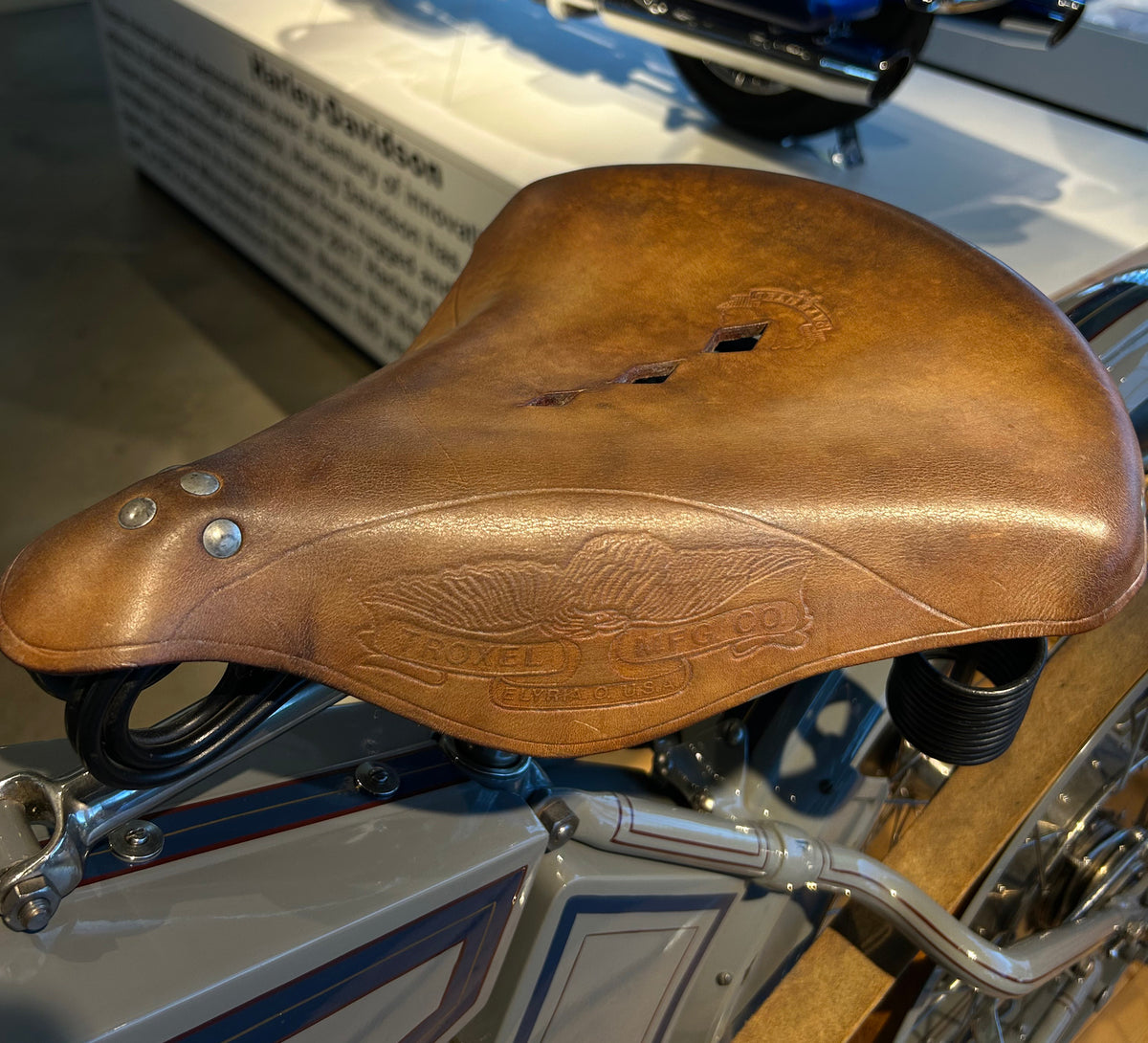
The Beauty of Leather Aging and Patina Development
Patina is one of the most celebrated characteristics of leather, a natural evolution that tells a story unique to every item. Over time, as leather interacts with its environment and the hands of its owner, it develops a sheen, texture, and depth of color that signify its journey. Here, we explore the art of leather patina—how it forms, how to encourage it, and how to preserve its unique charm.
What is Patina on Leather?
Patina refers to the natural changes in the appearance and feel of leather as it ages. Unlike synthetic materials, which degrade over time, leather’s aging enhances its character. The process results in deepened colors, subtle sheens, and unique markings that reflect the life of the item. It is a mark of authenticity and a testament to the material’s quality.
Factors Influencing Patina Development
- Handling and Use: Oils from hands and regular contact enrich the leather, creating polished areas and deepened hues over time.
- Sunlight and UV Exposure: Moderate exposure to sunlight can add depth and warmth to lighter leathers, creating a pleasing gradient of tones. Excessive exposure, however, should be avoided to prevent cracking.
- Moisture and Humidity: Occasional exposure to moisture contributes to the softening and toning of leather. However, consistent care is necessary to avoid water damage.
- Leather Type and Finish: Aniline and vegetable-tanned leathers are most prone to developing a rich patina due to their natural finishes. In contrast, pigmented or heavily coated leathers may show less patina but are more resistant to wear.
- Environmental Conditions: Dust, ambient air, and even minor scratches contribute to the leather’s aging, enhancing its natural textures and tones.
Maintaining Patina Without Jeopardizing It
Preserving patina is an art in itself, requiring a delicate balance between maintenance and respect for the leather’s natural aging process. Proper care involves understanding the unique qualities of patina and employing methods that enhance its development while preventing damage.
1. Gentle Cleaning
- Use a soft, damp, lint-free cloth to remove surface dust and dirt. Avoid excessive moisture, which can disrupt the leather’s natural balance.
- For deeper cleaning, use a pH-balanced leather cleaner specifically designed for untreated or lightly finished leather. Test the cleaner on an inconspicuous area first to ensure compatibility.
- Wipe in circular motions with minimal pressure to avoid stripping oils or altering the surface texture.
2. Conditioning with Care
- Select a conditioner formulated for natural or lightly finished leather to nourish without adding excessive sheen or clogging pores.
- Apply sparingly, focusing on dry or high-use areas. Use a clean, lint-free cloth or applicator to spread the product evenly.
- Allow the conditioner to absorb naturally and buff lightly to maintain a subtle finish. Over-conditioning can mask the patina’s development and lead to a waxy appearance.
3. Spot Treatments
- Address spills immediately by blotting with a soft, dry cloth. Avoid rubbing, as this can spread the stain or alter the patina.
- For stubborn stains, use a mild cleaner designed for the specific leather type. Work carefully in small, targeted areas and avoid over-saturating the surface.
- When in doubt, consult a professional leather specialist to ensure the patina is preserved.
4. Environmental Protection
- Store leather items in areas with stable humidity levels (40-60%) to prevent drying or mildew. Avoid direct exposure to sunlight for prolonged periods, which can cause uneven fading or cracking.
- Use breathable storage solutions like cotton dust bags or wooden hangers to allow airflow and prevent moisture buildup.
5. Handling and Daily Care
- Handle leather with clean, dry hands to avoid transferring oils or contaminants that can create uneven patina.
- Rotate the use of heavily handled items, such as bags or wallets, to promote even wear and aging.
- Avoid exposure to harsh chemicals, solvents, or excessive heat, which can damage the leather’s surface and interrupt patina formation.
6. Regular Maintenance
- Conduct routine inspections to identify areas that may require attention, such as scuffs or dryness.
- Use a horsehair brush to gently buff the surface, which can restore luster and enhance the depth of patina without adding artificial shine.
- For scratches, lightly rub the area with a fingertip or a soft cloth to redistribute natural oils and blend the mark into the surrounding surface.
7. Professional Restoration
- For significant damage or advanced preservation needs, consult a leather specialist who understands the importance of patina. Techniques like micro-repair, color blending, or customized treatments can maintain the integrity of the aged appearance.
By following these in-depth cleaning and care methods, you can ensure that patina continues to enhance the beauty and value of your leather goods. Proper maintenance celebrates the character of patina while preserving the timeless appeal of aged leather.
Preserving patina is an art in itself, requiring a delicate balance between maintenance and respect for the leather’s natural aging process:
- Gentle Cleaning: Remove dirt with a soft, damp, lint-free cloth to prevent abrasion. Avoid harsh chemicals that strip natural oils.
- Targeted Spot Treatments: Address spills or stains minimally, focusing only on affected areas to retain the surrounding patina.
- Professional Restoration: When repairs are necessary, consult professionals who specialize in preserving patina. Techniques like micro-repair or color blending can maintain the leather’s original charm.
- Proper Storage: Store leather in environments with balanced humidity to avoid excessive drying or dampness that could disrupt its aging.
Why Patina Matters
Patina is more than just an aesthetic feature—it is a testament to the quality, history, and individuality of leather. Genuine leather’s ability to age gracefully showcases its premium craftsmanship and material integrity. The unique markings, deepened tones, and natural sheen tell the story of its journey, reflecting the habits and lifestyle of its owner. Additionally, patina adds cultural and historical significance, especially in vintage goods, collectible vehicles, and heirlooms, making each item an irreplaceable piece of art that blends heritage with character.
Conclusion
The beauty of patina lies in its authenticity and individuality. By embracing the natural aging process of leather and understanding the factors that influence it, you can cultivate a deeper appreciation for your leather goods. Whether it’s a cherished bag, a timeless jacket, or the interior of a classic car, patina celebrates the journey of an item, blending heritage with character. Preserve it, enjoy it, and let it tell your story.
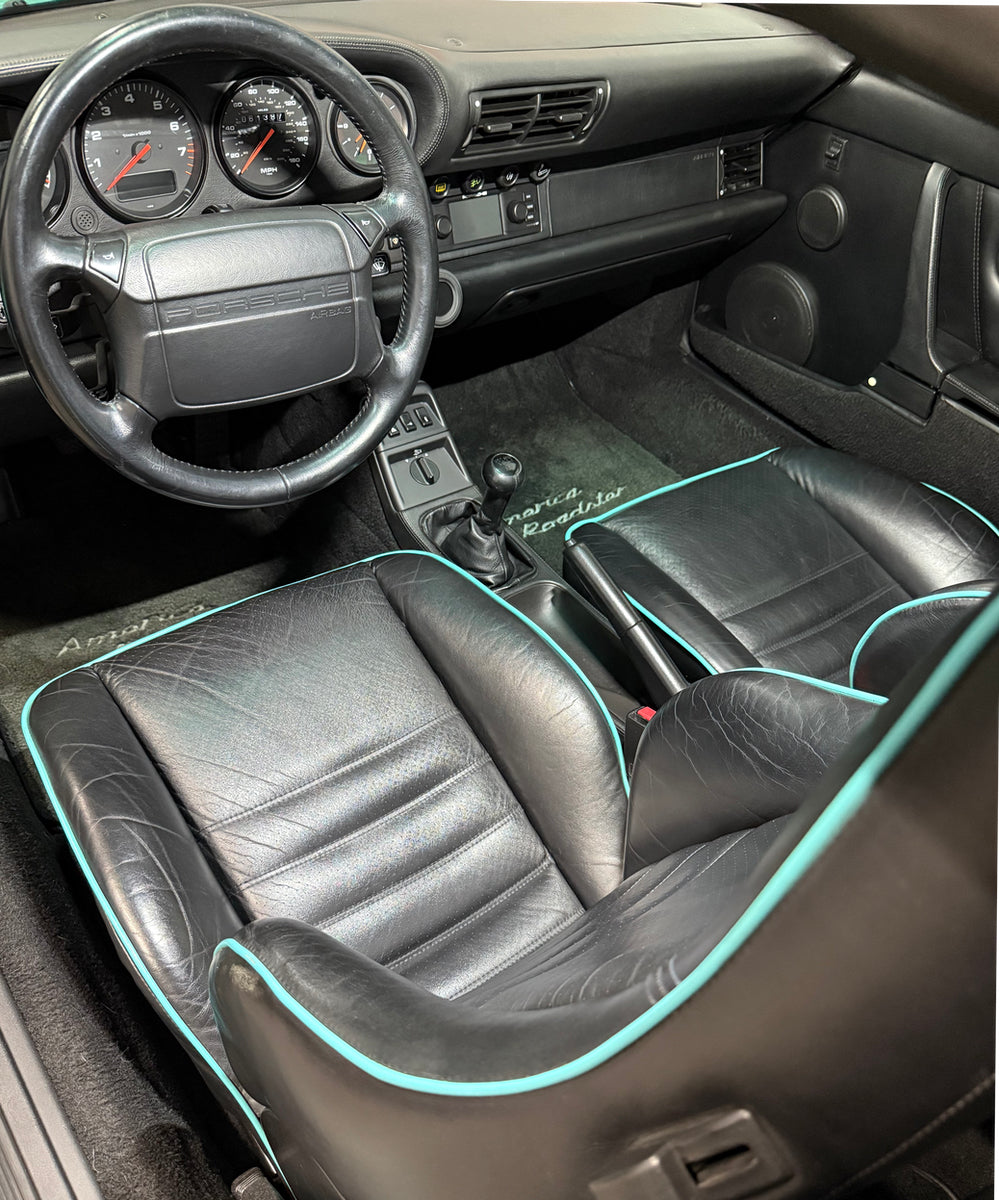
Can it be fixed
Making the decision to repair or replace
Practice & Experiance
Working with repair leather requires a lot of practice and attention to detail. No matter what the skill level, work in the situations that are the most comfortable.
Extending Expertise to the Detailing Community
Professional detailers are often tasked with caring for luxury leather interiors but may lack in-depth knowledge of the unique characteristics of high-end materials. Our offerings are designed to fill this gap:
- Comprehensive Training Programs:
We provide detailed instruction on identifying leather types, assessing wear and damage, and using the appropriate products for cleaning, conditioning, and repair. - Advanced Techniques for Sensitive Leathers:
Training includes handling semi-aniline, aniline, and other sensitive leathers that are commonly found in luxury vehicles and goods, focusing on preventive care and treatment of issues like dye transfer.
Why Education Matters
Leather care requires a balance of science and craftsmanship. By understanding the qualities of luxury leathers, such as their softness, natural markings, and limited protective coatings, owners and professionals can make informed decisions about their upkeep.
With our guidance, owners can enjoy their high-end items with confidence, and professionals can deliver superior services, ensuring that the elegance of these materials is preserved for years to come.
Feel free to reach out for assistance, whether it’s a consultation, training inquiry, or questions about your leather. We're here to support both individuals and the professional detailing community in elevating leather care standards.
